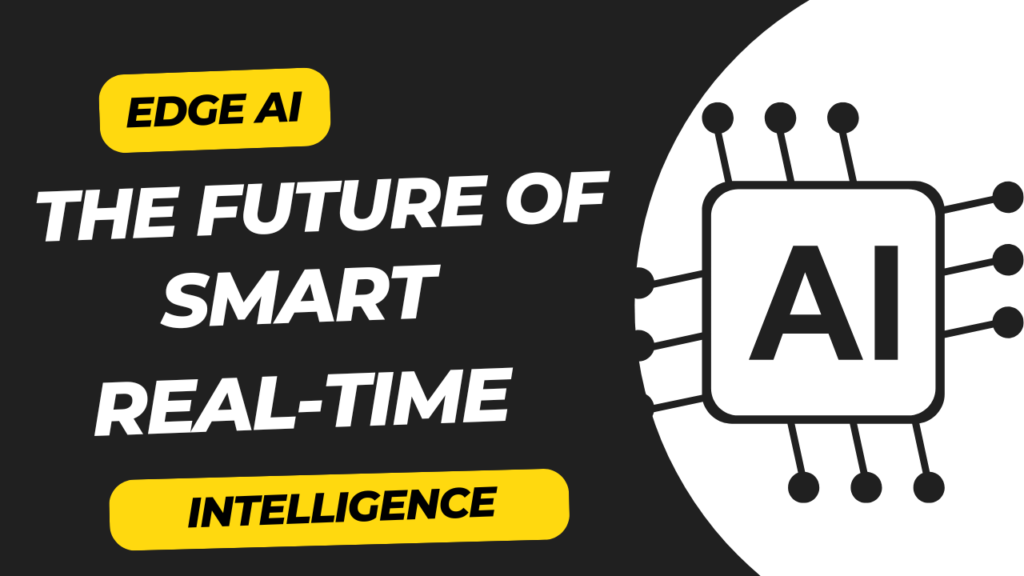Imagine an AI that processes data instantly, without relying on the cloud, making real-time decisions on your phone, car, or even a tiny IoT device. No delays, no lag, just instant intelligence.
This is Edge AI—a revolutionary approach where artificial intelligence runs directly on local devices instead of depending on remote cloud servers. It’s faster, more secure, and energy-efficient, making AI smarter, more private, and everywhere.
From self-driving cars and AI-powered smart cities to real-time healthcare monitoring, Edge AI is set to reshape industries and bring intelligence to the very edge of technology.
Let’s explore how this game-changing AI works and why it’s the future of computing. 🚀
🌟 What is Edge AI?
Edge AI is the combination of artificial intelligence (AI) and edge computing, where AI models process data locally on devices instead of relying on distant cloud servers.
Unlike traditional AI that requires sending data to the cloud for processing, Edge AI enables devices to think and act in real-time, making it ultra-fast, private, and efficient.
🔑 Key Features of Edge AI:
⚡ Ultra-Low Latency – AI decisions happen instantly on local devices, perfect for real-time applications like self-driving cars and robotics.
🛡 Enhanced Privacy & Security – Since data never leaves the device, sensitive information stays protected, reducing hacking risks.
🔋 Energy Efficient – Edge AI consumes far less power than cloud-based AI, making it ideal for IoT, wearables, and battery-powered devices.
🌍 Works Without Internet – Edge AI keeps working even in remote locations or offline, crucial for smart agriculture, military, and disaster recovery.
💡 Cost-Effective & Scalable – Reduces cloud storage and bandwidth costs, making AI cheaper and more scalable for businesses.
🚀 How Does Edge AI Work?
Edge AI relies on three core technologies to bring intelligence closer to the source:
1️⃣ Edge Devices (Where AI Runs)
🛠 Examples: Smartphones, drones, autonomous vehicles, IoT sensors, cameras, and industrial robots.
These devices are embedded with AI chips (like Google’s TPU, Apple’s Neural Engine, and NVIDIA Jetson) to process AI models locally.
2️⃣ AI Models Optimized for Edge Computing
💡 AI models like TinyML and TensorFlow Lite are optimized to run on low-power devices, ensuring AI works fast and efficiently even with limited hardware.
3️⃣ Edge Servers & Gateways (For Hybrid AI)
🔄 In some cases, Edge Servers process data partially on the device and partially on a nearby server, reducing cloud dependency while keeping AI powerful.
🔥 Real-World Applications of Edge AI
Edge AI is transforming industries by making AI faster, smarter, and more accessible than ever before.
🚗 1. Autonomous Vehicles & Drones
🚦 Self-Driving Cars – Edge AI allows autonomous vehicles to process sensor data in real time, making split-second driving decisions without relying on cloud servers.
🚁 Drone Swarms & Delivery Systems – Edge AI enables drones to navigate, avoid obstacles, and deliver packages with incredible precision.
🏥 2. Healthcare & Wearable AI
🩺 AI-Powered Smartwatches – Devices like the Apple Watch and Fitbit use Edge AI to monitor heart rate, detect irregularities, and even predict potential health issues—all in real-time.
🔬 AI in Medical Imaging – Edge AI speeds up cancer detection by analyzing X-rays and MRIs instantly on medical devices, reducing diagnosis time from days to seconds.
🏙 3. Smart Cities & Surveillance
🚦 AI Traffic Control – Edge AI optimizes traffic lights in real-time to prevent congestion, reducing commute times and pollution.
📹 Real-Time Security Surveillance – Edge AI-powered CCTV cameras detect suspicious activity instantly, improving public safety without requiring constant cloud connectivity.
🤖 4. Industrial Automation & Smart Factories
🏭 Predictive Maintenance – Edge AI helps factories predict machine failures before they happen, preventing costly breakdowns.
🔧 AI-Powered Robots – Edge AI allows robots to adapt to real-world changes in real time, improving efficiency in manufacturing and warehouses.
🌍 5. Smart Homes & IoT
🔊 Voice Assistants Without the Cloud – Future Alexa and Siri versions may process commands locally, making responses instant and private.
💡 AI-Powered Smart Devices – Edge AI allows smart refrigerators, thermostats, and appliances to learn user habits and adjust settings without cloud dependence.
🏗 Challenges & Limitations of Edge AI
While Edge AI is groundbreaking, it still faces some challenges:
⚡ Limited Processing Power – Edge devices have lower computing power compared to cloud servers, making it harder to run large AI models.
🔋 Battery Constraints – Running AI on small devices requires ultra-efficient energy management to prevent battery drain.
🔄 Software & Model Optimization – AI models need to be compressed and optimized to work on low-power edge hardware.
🛡 Security Risks – Edge devices are physically accessible, making them vulnerable to hacking or tampering if not properly secured.
Despite these challenges, tech giants like Google, Apple, Intel, and Qualcomm are heavily investing in Edge AI, creating more powerful, efficient, and secure AI chips.
🔮 The Future of Edge AI: What’s Next?
🚀 AI Without the Internet – Future AI assistants will process voice, images, and text locally, making them faster and more private.
⚡ Hyper-Efficient AI Chips – Advancements in neuromorphic computing and quantum AI will make Edge AI 100x more powerful while consuming less energy.
🤖 Human-Level AI on Edge Devices – AI assistants will become more personalized and context-aware, adapting to users in real-time.
🛰 Edge AI in Space Exploration – NASA is developing AI systems that can process data on Mars rovers and satellites, enabling autonomous decision-making in deep space.
🌍 AI for Global Connectivity – Edge AI will bring intelligence to remote villages, disaster zones, and developing regions, improving lives without requiring expensive cloud infrastructure.
🎯 Final Thoughts: Edge AI – The Next AI Revolution
Edge AI is changing the way AI interacts with the world—bringing intelligence closer to where decisions need to be made. It’s faster, more private, and energy-efficient, making AI more accessible than ever.
From self-driving cars and health-monitoring wearables to AI-powered cities, Edge AI is creating a smarter, more connected world—without relying on the cloud.

